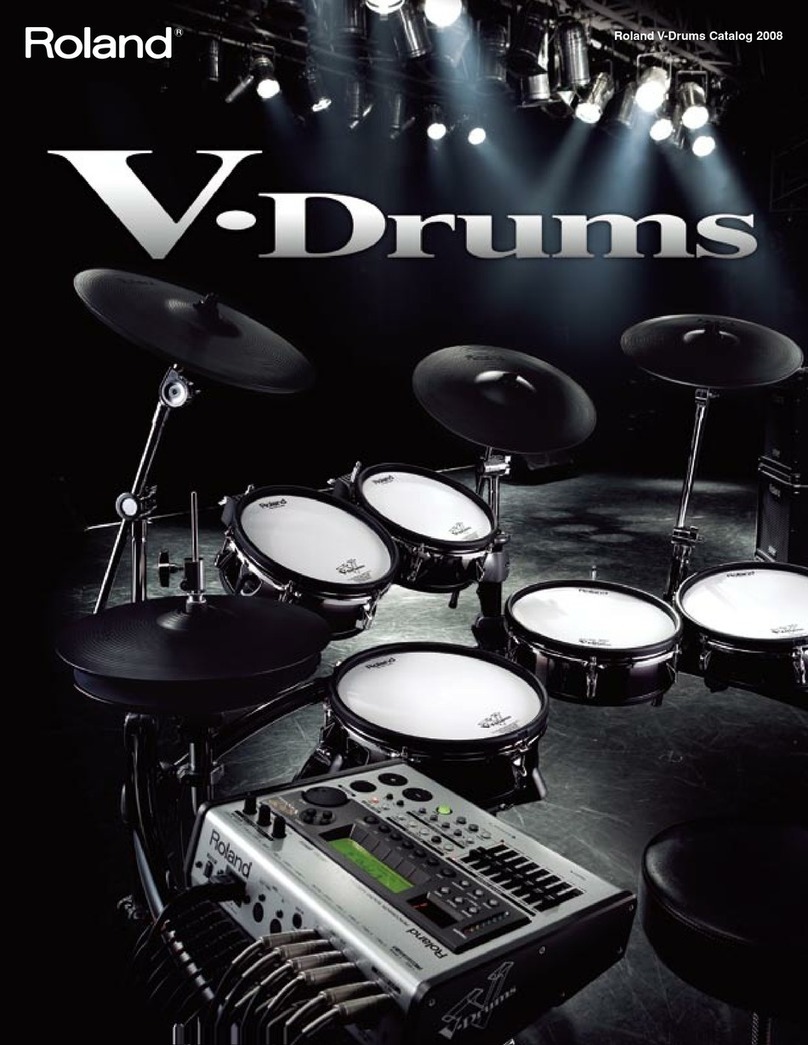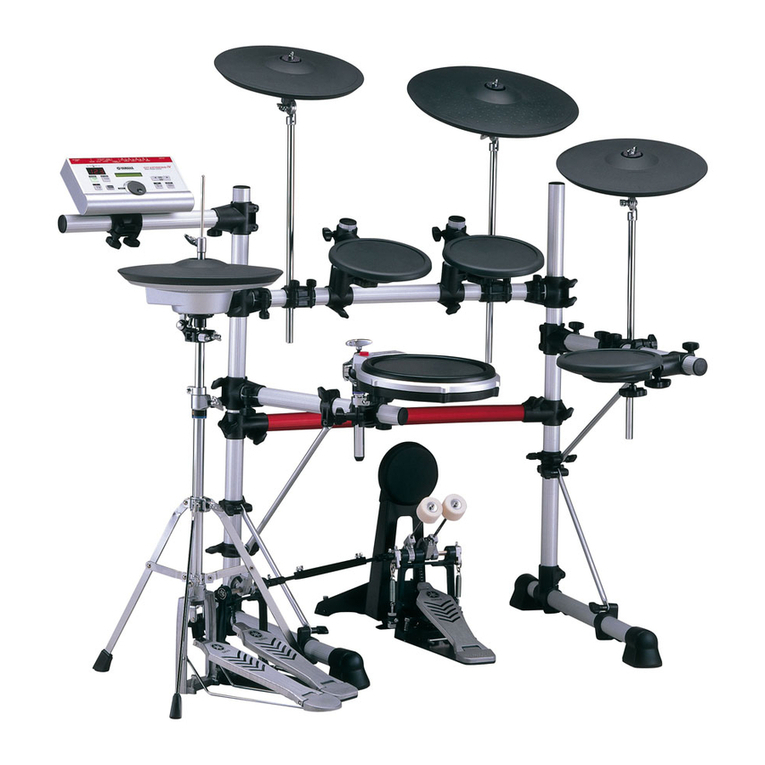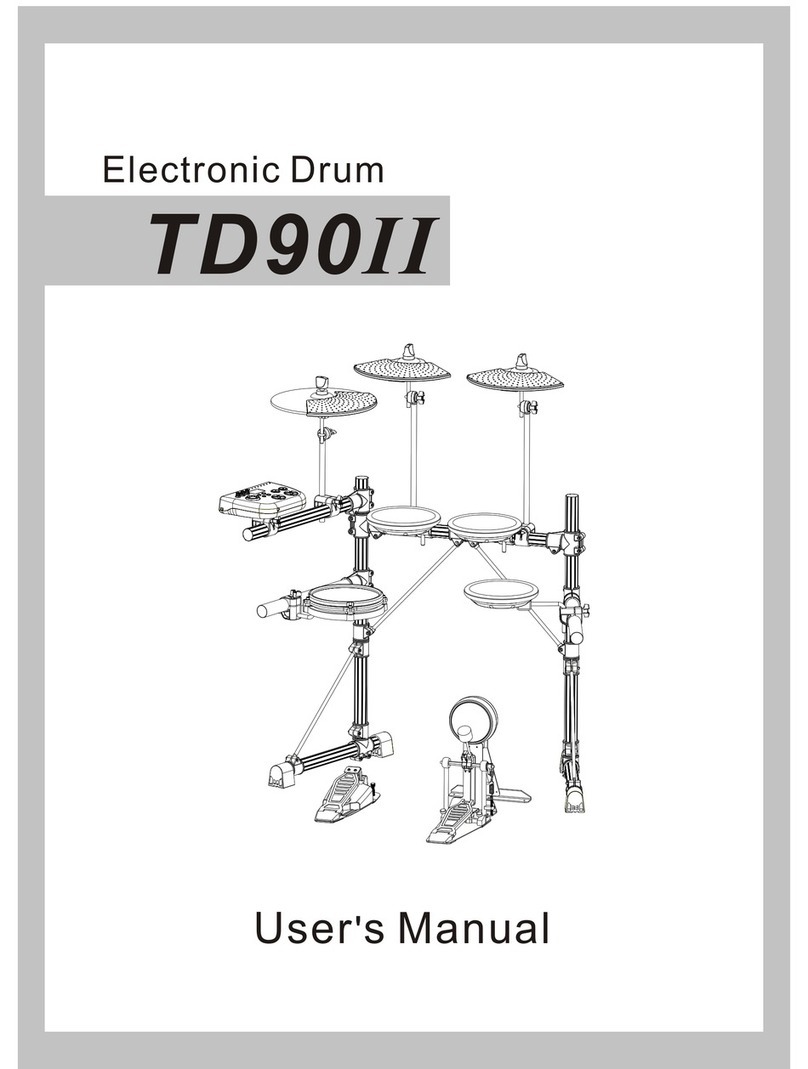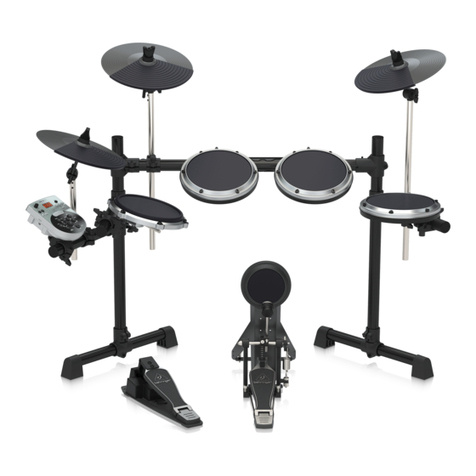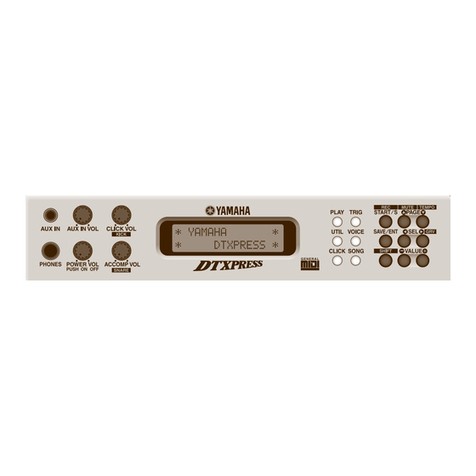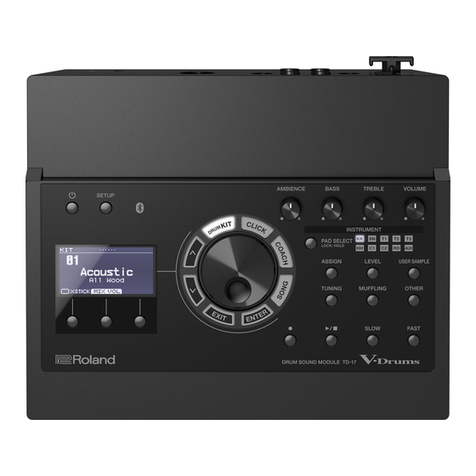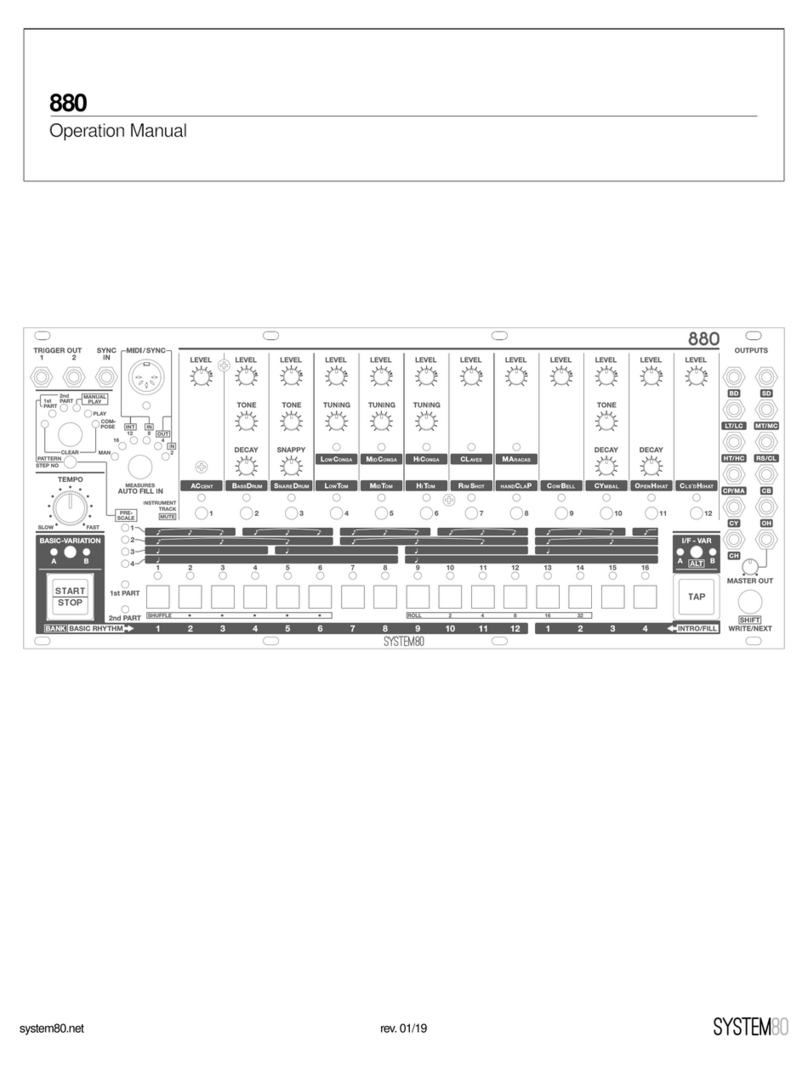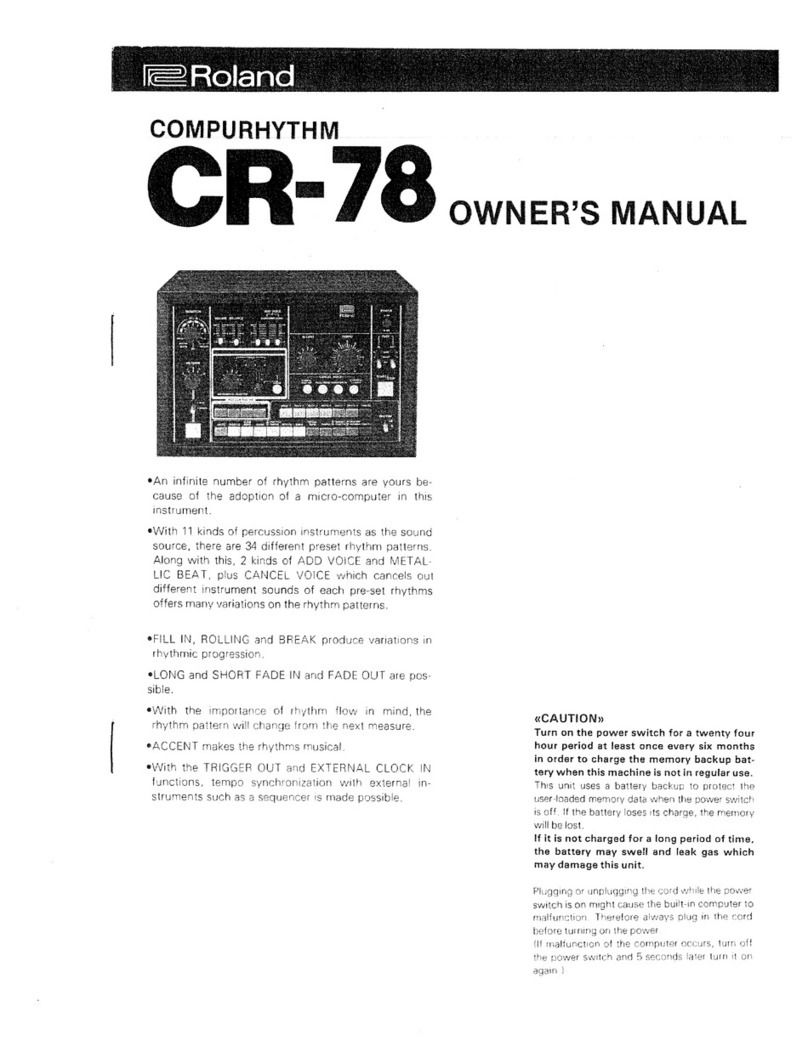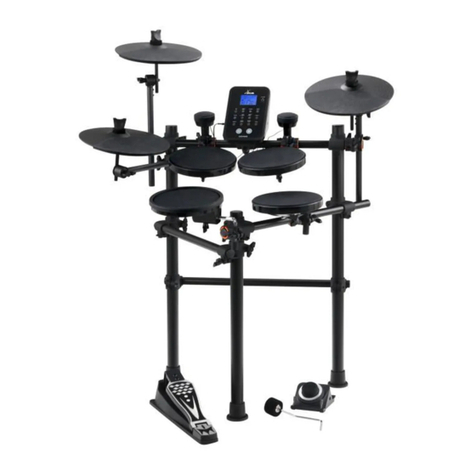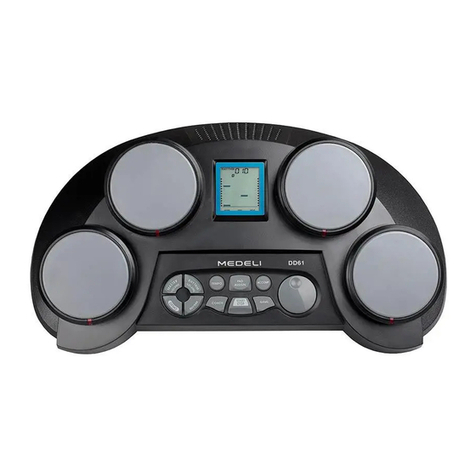Bleeplabs BLEEP DRUM User manual

The BLEEP DRUM
v001 (board 012 code 003)
Thank you for your purchase, fellow noise-maker!
Here are the tools you’ll need to assemble the Bleep Drum:
- Soldering iron
Pen type, 35W max with a good tip. Like this. See Soldering 101 for more info. You
will also need something to deal with soldering fumes and to clean the soldering iron.
- Solder
20 gauge (.032”) is good for most kits. Large solder should be avoided. Most compo-
nents we use are RoHS. Lead-free solder isn’t necessary but is recommended.
- Cutters
Diagonal or flush.
- Small pliers
Something like these.
- Screwdrivers
Large and mini athead.
All Bleep Labs kits can be completed by those who are new to soldering, but it is very important
that you know how to solder safely before you start. This includes working in a well-ventilated
area and wearing safety glasses.
Children should never solder alone and should never handle anything that might contain lead.
If you are new to soldering or need a refresher, check out these tutorials.

Resonator
Capacitors LED 78l05
Resistors
12mm tactiles
6mm tactiles
Potentiometers
1/8” jack
Switch
Atmega328 MCP4901
DIPs
9V holder
1 1/2” screw
1/4” screw
4-40 nut
Feet
Back Plate
PCB
Knobs
Page 1
Circuit board 1
Bottom panel 1
ATMEGA328 28 pins “328” 1
MCP4901 8 pins “4901” 1
78l05 3 pins 1
DIP socket 14 pins 2
DIP socket 8 pins 1
Resonator 16MHz 1
Potentiometer 10k or 20k 2
Tactile button 12mm 4 colors 4
Tactile button 6mm 4
Capacitors 220 or 100 uf “C1” 2
10uf “C2” 1
Resistors 10k “R1” 5
LED RGB 1
1/8” jack stereo 1
slide switch SPDT 1
Knob 2
Screw 4-40 1 1/2” 4
Screw 4-40 1/4” 4
Nuts 4-40 small 14
9v holder 1
feet 4

1
The rst components to go in are the three
capacitors.
Insert them into the three dashed circles from
the bottom with the short legs in the holes
marked with a “ - “
2
Flatten the leads on the board...
... then clip off the excess.
Cut the legs so they are just on the outside of
the pads. Too short and the will fall out. Too
long and they might touch another pad and
cause a problem.

3
Solder the three capacitors in.
If you aren’t yet comfortable with soldering,
take a minute to looks at our soldering guides
at Sparkfun or Bleep Labs.
4
The DIP sockets go in next. The chips go into
these at the end.
The two 14 pin DIPs go in the space marked
“328”. The 8 pin goes in “4901”
5
Use a at head screwdriver to atten the pins
inwards

5
Install the large colored buttons in their places
and atten their pins just as you did with the
DIPs.
6
The small buttons go in just the same.
Be careful not to have your nger on the op-
posite side of their holes when you push them
through!
Flatten the pins just like before.
7
Next is the RGB LED. It goes in with the at
side on the left as shown on the board.

8
Bend the resistors and insert them into the
board in the ve places marked “R1”
Bend and clip the leads as before.
9
The black 78l05 and tan resonator go in as
shown here.
Bend and clip their leads.
10
The last components to go in on the top are
the potentiometers.
Before installing them, make sure that the ca-
pacitors installed on the bottom are in correct-
ly as they cannot be redone after the pots are
in.
You do not need to bend and clip the pots
leads.

11
Soldering
Before you begin, make sure that all of the
components are in the correct places and that
none of the leads are touching.
One you’re done, clip off the pots’ pins.
If you get some unsightly brown dots and want
to get rid of them, wait 15-30 minutes for them
to dry. Then carefully scratch them off with a
plastic disposable knife.
12
Once the bottom is fully soldered, there are
just a few things left to do before you can
make some boomclappoonnnchpewwwwwss.
Insert the 1/8” jack and the slide switch from
the bottom side. Fold the outside pins of the
switch outward with your screwdriver.
13
Last is the battery holder.
Use your pliers to pop and bend the pins out
of the plastic so they look like this.

13 continued
Install the battery holder into the pins that are
on either side of the 8 pin DIP.
13 continued
Before you solder the pins, take one of the
small screwdrivers. Hold it against the battery
holder as shown...
13 continued
... and tighten a nut on the other side.
Do the same with the other small screw on the
other side of the 9V holder.

13 continued
Now solder the pins.
Make sure the battery holder is as ush to the
board as you can get it. This is best achieved
by holding down the board on the table while
soldering the pins.
14
Install the chips. Gently squeeze their pins to-
wards each other so they t into the sockets.
Make sure the text is right side up and that the
notch is on the left.
Put a battery in and turn on the switch.
Success! You now have a functioning
beat-machine!
If you’re having problems with it:
- Are the chips in the correct direction?
- Is the battery dead?
- Do all the solder point look like they should?
It’s not enough for there to just be some solder
on them. Large blobs of solder might not be
conducting properly. You should not be able
to see the pad.
If it doesn’t come on and you’ve checked ev-
erything a couple times, the best advice is to
come back to it later. Seriously! I cannot count
the number of times I have spent hours infuriat-
ed by a project, only to look at it the next day
and nd the problem immediately.
If you still have problem, feel free to contact us

15
Now for the bottom panel.
Insert nuts into each of the holes on the plastic
panel.
15 continued
Put a long screw through a corner hole of the
board. Put two nuts on it as shown.
15 continued
Turn the screw through the nut in the plastic
plane until it is ush with the nut. It should not
poke through.

15 continued
Use your pliers to tighten the two nuts. One to
the bottom panel and one to the PCB.
15 continued
Stick the clear bumpers on top of the nuts.
16
Screw the knobs onto the pots so that the tiny
screw is against the at side of the shaft.

You’re done!
Have fun making noise!
have any questions or issues with your new
drum buddy.
User guide
The Bleep Drum code v003
The left knob controls the pitch of the red pad, the snare.
Right knob controls the blue, tom pad.
Play – Stop and start playback of selected sequence. Light will blink white on the beat.
Record – Start and stop additive recording. Any pad played will be added to the sequence.
Light blinks red.
Tap – Tap tempo
Shift + pad = Change to that color sequence. Light will change to that color.
Shift + right knob = Change tempo with knob.
Shift + Play = Reverses samples
Play + Record = Erase current sequence.
Blue and yellow sequences start with kick on the 1 and 3.
NOISE MODE 30XX
Hold shift while turning on the device. The light will turn green. Hitting shift again will turn it pink and blinky
Green - Pots control the pitch just like normal
Pink - Pots control noise.
All other controls are the same.

Hacking
1 - Ground
2 - Trigger output (high pulse every 1/8th)
3 - +5V
4 - Trigger yellow
5 - Trigger input (low pulse advances 1/8th)
6 - Trigger blue
7 - Trigger red
8 - Trigger green
9 - TX
10 - RX
11 - +9V (Straight from battery)
12 - Reset
When a low pulse is sent to one of the trigger
color buttons, that pad is activated.
Nothing is currently programmed for the se-
rial but MIDI shouldn’t be too hard to add...
This manual suits for next models
1
Table of contents

